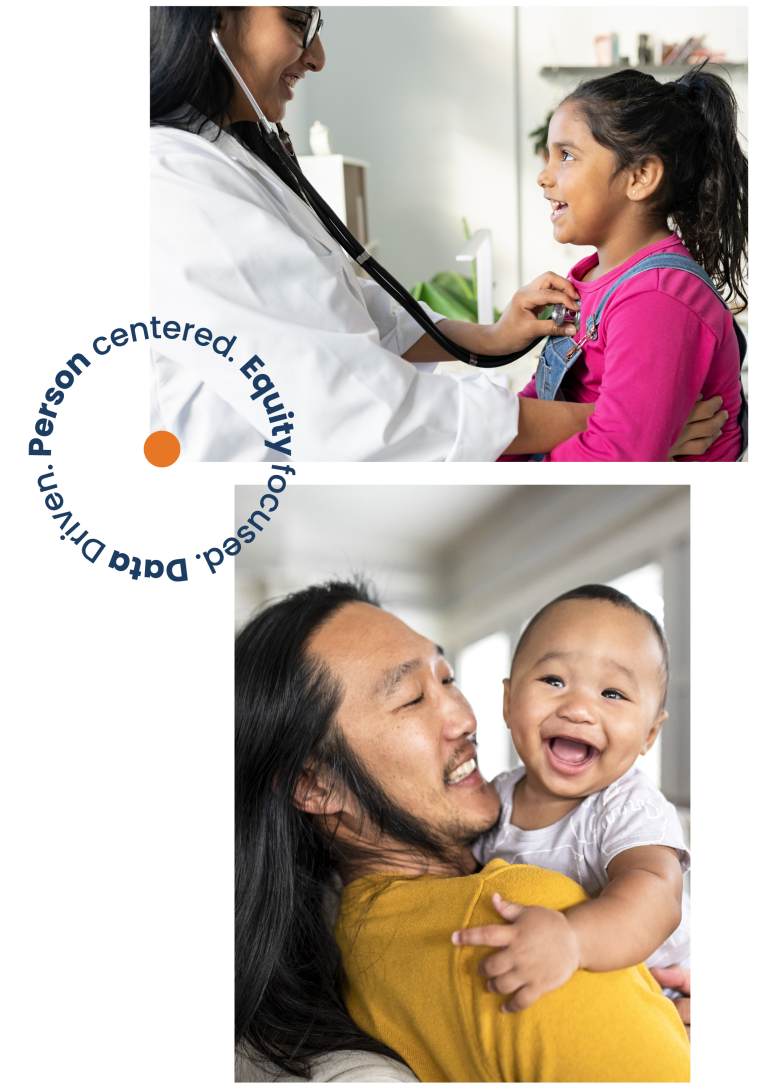Guiding Principles & Strategic Priorities
Our Guiding Principles
We will lead in advancing equity and strive to create programs that address systemic inequities. We will work to achieve a California where race, ethnicity, gender identity, sexual orientation, disability and other forms of social categorization no longer predict a person’s or community’s health and life outcomes. We will remove barriers so that all Californians have a fair opportunity to meet their needs and achieve their goals.
We will seek out and proactively listen to the individuals and communities we serve to better understand their conditions, needs, and recommendations. This will help us develop better policies, programs and services that truly meet the needs of the individuals, families and communities. Building collaboration and self-determination into program design leads to better relationships and ultimately to better outcomes.
We will harness the power of data to better understand the well-being of those we serve, assess the impact of our programs, and identify opportunities for improvement. By integrating, interpreting, and sharing data responsibly, we will generate timely, actionable insights to drive informed decision-making, advance social and economic mobility, and improve the health and well-being of all Californians.
We will always think about what each person needs to thrive, considering the cultural, economic and social factors impacting people’s lives. We will work to align or integrate programs to meet individual needs across departments – both within government and through our community partners. Our focus is on the needs of the people we serve, rather than the siloed structures of government and its programs. Person-centered programming honors the needs, preferences, and values of those being served and respects the dignity and autonomy of individuals and families.
We will implement resilient systems and service delivery models that can be flexible and responsive to diverse and emergent needs. The relentless pursuit of innovation, applied thoughtfully, will catalyze our improvement efforts. We will design programs and services collaboratively across departments, including those outside CalHHS. We will seek feedback from and partner with counties and community-based organizations and consult with tribes to drive creative solutions to meet the needs of all Californians.

Our Strategic Priorites
North Star:
All Californians have meaningful and timely access to care, live in healthy communities, and our zip codes no longer predict our health outcomes.
Roadmap:
- Lead the nation in increased health care access, affordability, accessibility, and coverage and disrupt the market for essential medicines.
- Modernize our behavioral health system to provide services to help anybody, anywhere, anytime by investing in prevention and increasing the availability of early intervention and outpatient services while expanding community-based treatment and residential care for individuals on their path to greater self-reliance and independence.
- Develop innovative workforce models and expand culturally and linguistically competent care.
- Prioritize prevention and the upstream factors that impact an individual’s health and well-being.
- Reproductive health is health care. Ensure that California remains a safe haven for safe, legal, and accessible care.
North Star:
Across our delivery systems we integrate programs to provide whole person care and address the social drivers of health.
Roadmap:
- Address the upstream drivers of health, including housing and food insecurity, through programs to address the complex challenges facing California’s most vulnerable residents, including people experiencing homelessness, individuals with serious behavioral health conditions, those who are justice-involved and the growing
aging population. - Reduce homelessness, especially chronic homelessness, by focusing on a “housing first” strategy and building up permanent supportive housing and the support services needed by those we serve.
- Integrate food and social services innovations to prevent chronic disease.
- Strengthen policies and procedures to govern the exchange of health and human services information through the Data Exchange Framework to support integrated care coordination and improve health outcomes.
North star:
Every individual belongs to a strong, thriving, and resilient community where we see our
diversity as our strength.
Roadmap:
- Support economic growth and improve state-wide workforce efforts by building career pipelines, offering financial support, and expanding education opportunities to allow Californians to obtain good paying jobs with future growth, regardless of ability or circumstances.
- Simplify and streamline access to the health and social safety net.
- Further immigrant integration efforts by providing legal services, social supports, and access to health care.
- Innovate, simplify, and improve language access capabilities across programs and delivery models to improve access to all services for every individual.
- Help communities experiencing discrimination find support and strengthen their sense of belonging and inclusion in California.
North star:
All children can play, learn, and thrive, and we are confident that we have done all we can to pass to them a state they can lead into the future.
Roadmap:
- Build a more integrated, prevention-oriented, youth-centered behavioral health ecosystem that meets the needs of all young people and families so that they can find services and support for mental health and substance use needs where, when and in the way they need it most.
- Improve outcomes for children living in deep poverty, in foster care, and in the juvenile justice system by addressing adverse childhood experiences, early childhood and education needs, and improving access to trauma-informed, community based interventions and comprehensive, integrated physical health, mental health and social services.
- Keep families together whenever possible and shift the focus from mandated reporting of child neglect and abuse to community support.
- Implement foster care rate reform to accelerate a kin-first culture, promote reunification, and increase placements with relatives, improving outcomes for foster youth and reducing long-term adverse outcomes such as untreated serious mental illness, homelessness, and incarceration.
- Expand access to childcare subsidies and improve the quality of childcare and development services.
North Star:
Older and disabled Californians can live with purpose and dignity, with opportunities for equal participation in all aspects of life and society.
Roadmap:
- Advance the goals of the Master Plan for Aging and the Master Plan for Developmental Services and mobilize state government, local communities, private organizations and philanthropy to harness the state’s innovative spirit, channel resources where they are needed most, and open new opportunities to create inclusive, equitable communities for Californians
of all ages and abilities. - Establish a local aging network that creates a more seamless experience of home and community-based services and reduces health inequities across the lifespan.
- Create more choices for home and community living, including expanded service options, affordable and accessible housing models, health care partnerships with Medi-Cal and Medicare, and support for family and paid caregivers – with easier navigation and coordination for diverse adults and families.
- Improve employment outcomes for Californians with disabilities and provide opportunities for Californians with intellectual and developmental disabilities, regardless of the severity of their disability, to prepare for and participate in competitive integrated employment.



